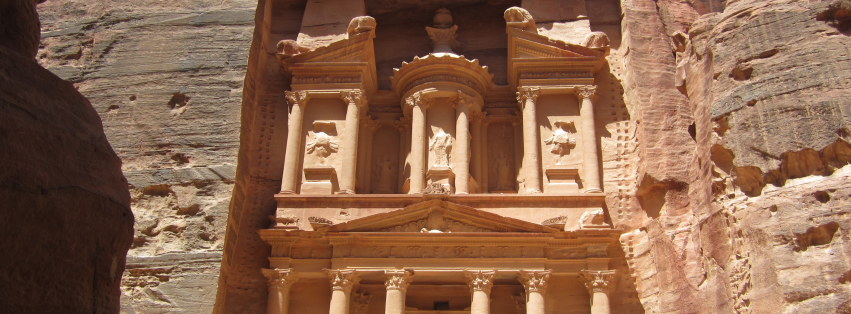
Location
Amman, Jerash, Petra, Ajloun, Jordan
Program Description
Students will earn three credits of coursework by enrolling in one of the two courses offered by the program. Some material will be covered online before departure. In Jordan, there will be daily morning meetings during the intensive two-week session. During the program, students will visit historical, cultural, and religious sites of the city of Amman and other cities and locations in Jordan, and can enjoy the culinary traditions of the region in general and Jordan in particular. The program also includes a one-day trip to Petra, the Rose City.
The program offers an immersive study of the culture and history of Jordan within a wider regional context, combining classroom instruction with experiential learning. Highlights include visits to several museums, excursions to significant historical and cultural sites, and cultural immersion through interactions with locals. Students will explore the cultural and historical background of the sites they visit and learn about life in Jordan by visiting museums, the remains of Greco-Roman cities, early Islamic Umayyad castles and palaces, the famous Nabataean capital of Petra with its rock-cut structures, and other sites of historical and cultural importance.
Location Description
This two-week program will be based in the city of Amman, the capital and largest city of Jordan, and one of the fastest-growing Arab cities economically. The city is located in north-west Jordan, and it is the chief financial, political, and cultural center of the country. It is also one of the principal commercial and transportation centers of the region, as well as one of the Arab world's major cultural capitals. The Greater Amman area has an estimated population of almost 4 million people.
Amman has a settlement history stretching back thousands of years, and the city is referred to in the Bible. It was the capital of the Ammonites in the 13th century BC, while during the Greco-Roman period, Amman was part of the Decapolis (a Hellenistic league of ten cities). However, the city is essentially a product of the modern period and has been growing rapidly from the middle of the 20th century to the present.
Jordan occupies an area rich in archaeological remains and religious traditions dating back thousands of years. Throughout the program, students will visit a number of historical, religious, and natural locations outside of Amman. The ancient biblical kingdoms of Moab, Gilead, and Edom lie within the borders of Jordan, as does the famed red stone city of Petra, the capital of the Nabatean kingdom and of the Roman province of Arabia Petraea. Other sites include the Greco-Roman city of Jerash/Gerasa and the Crusader era castle of 'Ajlun/Ajloun. A number of locations in Jordan have been designated as UNESCO World Heritage sites. These are Petra, Quseir Amra, Um er-Rasas (Kastrom Mefa'a), and the Wadi Rum Protected Area. All of these sites will be visited during the program.
There are numerous attractions in Amman, including shopping malls, restaurants, and cafes. A number of cities and towns are all within a short travel distance. All locations are accessible via the extensive public and private transportation systems (buses and taxis).
Director
Aram Shahin | shahinax@jmu.edu | World Languages and Cultures
Accommodations
Students will stay in shared furnished apartments or hotel rooms that come equipped with Wi-Fi/internet access and other amenities. These accommodations are located near supermarkets and restaurants.
The program covers all meal expenses (21 per week). Students will receive a meal stipend for daily meals, including breakfast, lunch, and dinner. There will also be a couple of group meals organized by the program.
Additional Items to Consider
Visas for US citizens can be obtained at the airport in Jordan. Citizens of other countries should check with the director or with the websites of the Jordanian embassy in the US.
Some work online will be required prior to departure. The material will be made available after the end of the fall semester and students have up to the date of departure to complete the assigned work.
Applicant Criteria
Applicants must have a GPA minimum of 2.0.
Open to all majors and class levels, including graduate students and non-JMU students.
There is no language requirement. Some knowledge of Arabic would be helpful, but not required.
Application Process
This list serves as an application preview. To apply, students will need to complete the following:
- Study Abroad Online Application ($40 fee)
- Short Essay
- Interview with program director required
- Unofficial transcript required for JMU students; Official transcript required for non-JMU students
Further details and instructions about these application requirements will be available upon log-in.
Application Deadline
Dates
All dates are tentative and subject to change
Courses
ARAB 447: Special Topics in Arabic Civilization and Culture: Bilad al-Sham (Greater Syria): 2,000 Years of History and Culture (3 credits)
HUM 252: Global Cultures: Greater Syria: 2,000 Years of History and Culture (3 credits)
Courses listed here are to be used as a general guideline for program curriculum. *All courses are considered pending until approved by the Academic Department, Program, and/or College.
